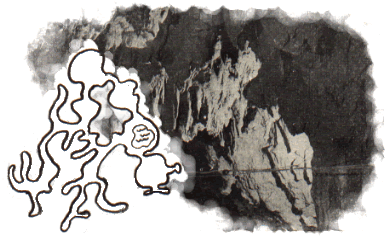     |
    
|
| Cumber
Poidy. "Anyone who lands on the Isle of Yunck expecting to see a town will be confused and disappointed. The casual eye sees nothing here but a mound that rises into a mountain, falling, at its apex, into a gigantic sinkhole. A thick, steady stream of water pours down this hole and disappears into the darkness. It is an impressive and unusual sight, but surely not worth all the trouble they went to crossing the violent water of Pithistle Strait. A casual stroll around the island reveals nothing beyond a series of low mounds which lie scattered across the remains of the area. They hear laughter, human voices blown back and forth by the wind, but where are these noises coming from? The visitor with any susceptibility will shudder here. The island seems haunted. Then his foot strikes against something flat and hard on the top of one of the mounds and he wonders what it is. The mound opens. He has just knocked on somebody's front door." (From A month in Cumber Poidy, by Stanley Godribbon.) A network of underground caves forms the skeleton of the Cumber Poidy settlement. These caves lay undiscovered for centuries, even while the island was being used as a handy resting place for fisherpeople sailing the Strait. In the Year of Established Stone (1530), a band of Exians climbed down the hole at the bottom of the Poidy Waterfall and there they found a lake inside a large cavern which gave way to a honeycomb of chambers and tunnels.  A map of Cumber Poidy's tunnels. Modified by the Exians into an inescapable jail, the caves were filled with prisoners in the Year of the Prison (1600). The jail was dismantled in the Year of Spreading (1687). (See The Cumber Poidy Prison for details.) Today, the former prison is inhabited by descendants of the prison guards and prisoners of long ago. Poidians are gracious and hospitable toward visitors, but any outsider who plans to move in for good must be prepared to wait for a while before they are fully absorbed into town life. They are entering a very close-knit community. It is also a surprisingly wealthy community, thanks to the Poidians' skill in exploiting the abundance of edible marine delicacies common here but rare in the rest of the country. The Yunck oyster and deep-sea Table Weed are two prominent examples. The Governor's chambers, formerly the home of the Cumber Poidy's prison governor, is the grandest set of caves in the town. It is the only home without a second doorway in the roof. To access the entrance, one must first walk along a narrow path around the Cumber Poidy Lake, pass behind the curtain of the Poidy Waterfall and cross the Great Hall. The Governor's Ministers and their families live adjoining this hall in the rooms that used to house the prison doctor, the cook and most of the guards. The nearby jetty is Cumber Poidy's only connection to the mainland. Read about the group of volunteers who maintain the jetty's health: The Cumber Poidy Citizens' Jetty Watch Team Alliance. You can also read about the famous Cumber Poidy Choir. |